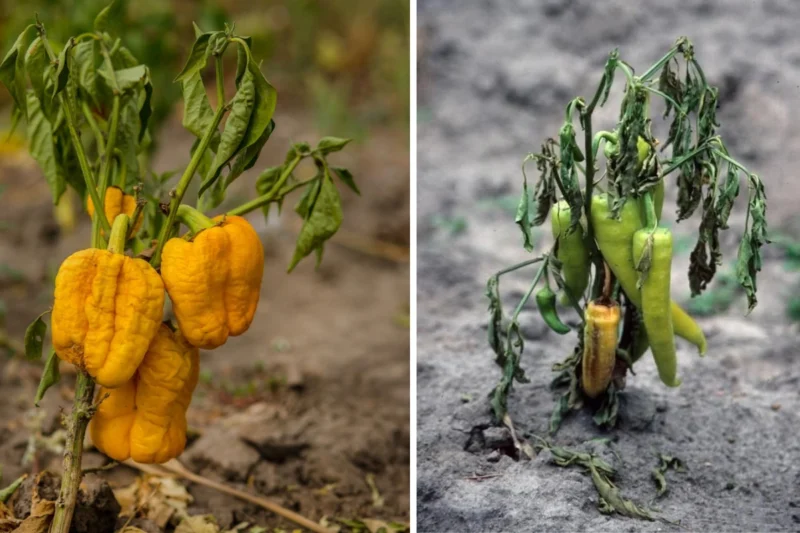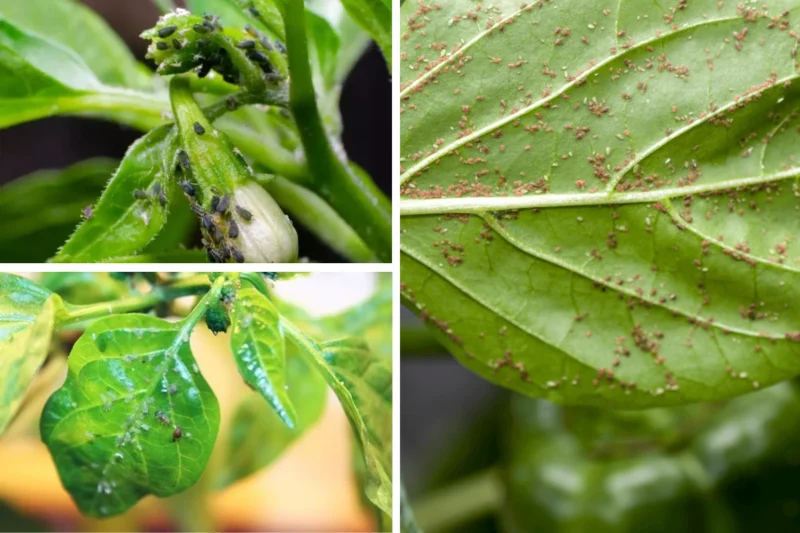Growing pepper plants can be incredibly rewarding, but what happens when your once-thriving plants start showing yellowing leaves, stunted growth, or wilting? If you’re here, chances are you’re dealing with some frustrating pepper plant problems.
Don’t worry—I’ve got you covered! In this guide, I’ll walk you through the most common pepper plant problems affecting pepper plants and how you can fix them quickly and effectively. Whether you’re dealing with pests, diseases, or environmental stress, this post will help you identify, prevent, and treat problems before they ruin your harvest.
1. Yellowing Leaves (Nutrient Deficiencies or Overwatering)
Yellowing leaves are one of the most common concerns for pepper growers. This condition is often linked to nutrient deficiencies or improper watering. If your pepper plants’ leaves are turning yellow from the bottom up, it’s likely a nitrogen deficiency. Magnesium and iron deficiencies can also cause yellowing, especially if the veins of the leaves remain green while the areas in between turn yellow.

Overwatering is another culprit. Pepper plants prefer well-draining soil, and too much moisture can lead to root rot, further exacerbating the problem. To fix yellowing leaves:
- Ensure proper soil drainage and allow the top layer of soil to dry before watering again.
- Apply a balanced fertilizer rich in nitrogen (N), phosphorus (P), and potassium (K).
- Add Epsom salt (magnesium sulfate) if magnesium deficiency is suspected.
- Consider a soil test to identify specific nutrient deficiencies.
2. Wilting or Drooping Plants
Pepper plants that suddenly wilt or droop may be experiencing water stress, root rot, or extreme temperatures. Underwatering deprives the plant of essential moisture, while overwatering suffocates the roots and promotes fungal infections.

If your plants appear limp despite adequate watering, check the soil. If it’s too wet, you may be dealing with root rot. Conversely, if it’s dry several inches deep, the plant may need more hydration.
Solutions:
- Water consistently, keeping the soil moist but not soggy.
- Improve drainage by adding organic matter or perlite.
- Provide shade during hot afternoons to prevent heat stress.
- Mulch around the base to retain moisture in dry conditions.
3. Blossom Drop (No Fruit Production)
It’s incredibly frustrating to see pepper plants bloom beautifully, only for the flowers to fall off without producing fruit. Blossom drop is typically caused by high temperatures (above 85°F during the day or 70°F at night), poor pollination, or over-fertilization with nitrogen, which promotes leafy growth over fruit development.
Solutions:
- Use shade cloth or water in the evening to cool plants during hot days.
- Attract pollinators like bees by planting flowers nearby or manually shaking flowers to assist in pollination.
- Apply a phosphorus-rich fertilizer rather than one heavy in nitrogen.
- Keep humidity levels moderate to encourage fruit set.
4. Brown or Black Spots on Leaves (Fungal & Bacterial Diseases)
Black or brown spots on pepper plant leaves could indicate fungal or bacterial infections. Bacterial Spot, caused by Xanthomonas campestris, thrives in warm, humid conditions and leads to leaf drop, reducing yields. Powdery mildew and early blight can also damage foliage.

Solutions:
- Improve airflow by spacing plants properly.
- Remove infected leaves and apply copper fungicide.
- Avoid overhead watering to prevent moisture buildup.
- Rotate crops annually to prevent disease carryover.
5. Holes in Leaves (Pests Attack)
If you notice holes or irregular-shaped tears in your pepper plant leaves, pests are likely the problem. Aphids, thrips, and spider mites are common culprits, sucking the plant’s nutrients and spreading diseases.
Solutions:
- Spray leaves with neem oil or insecticidal soap.
- Introduce ladybugs and lacewings, natural predators of aphids.
- Keep weeds under control to reduce pest habitats.
- Check the undersides of leaves frequently for early signs of infestation.
6. Pepper Fruits Rotting (Blossom End Rot)
Blossom end rot is a devastating condition where the bottom of the pepper fruit turns black and sunken. It is caused by calcium deficiency and inconsistent watering, making calcium uptake difficult for the plant.

Solutions:
- Apply calcium-rich fertilizers or crushed eggshells.
- Maintain consistent soil moisture to improve calcium uptake.
- Use mulch to retain soil moisture and prevent fluctuations.
- Avoid excessive nitrogen fertilization, which can interfere with calcium absorption.
7. Pepper Plant Leaves Curling
Curled leaves can be caused by heat stress, aphids, or viral infections such as the Pepper Mosaic Virus. If aphids are present, their feeding activity will distort leaf growth, while heat stress can cause leaves to curl inward as the plant tries to conserve moisture.

Solutions:
- Provide shade during heat waves.
- Check for aphids and use natural insecticides.
- Remove and dispose of infected plants if a virus is suspected.
8. Stunted Growth (Lack of Pollination or Poor Soil Conditions)
If your pepper plants are slow-growing and appear underdeveloped, poor soil fertility or lack of pollination could be the cause.
Solutions:
- Use compost or aged manure to enrich the soil.
- Ensure temperatures stay above 60°F for optimal growth.
- Hand-pollinate flowers if necessary.
9. White Powdery Coating on Leaves (Powdery Mildew)
Powdery mildew appears as a white, powdery substance on leaves, reducing the plant’s ability to photosynthesize. It spreads rapidly in humid conditions with poor airflow.
Solutions:
- Increase airflow by pruning plants.
- Apply organic fungicides like neem oil.
- Avoid watering leaves; instead, water at the base.
10. Peppers Not Turning Color
If your peppers stay green instead of ripening to red, yellow, or orange, it could be due to variety differences, temperature fluctuations, or harvesting too early.
Solutions:
- Be patient—some varieties take longer to change color.
- Ensure consistent watering and temperature control.
- Harvest at the right stage for your specific pepper variety.
Growing peppers successfully requires patience and proper care. By recognizing these common problems early and taking proactive steps, you can enjoy a healthy, productive pepper garden. Have you faced any of these pepper plant issues? Share your experience in the comments below!
